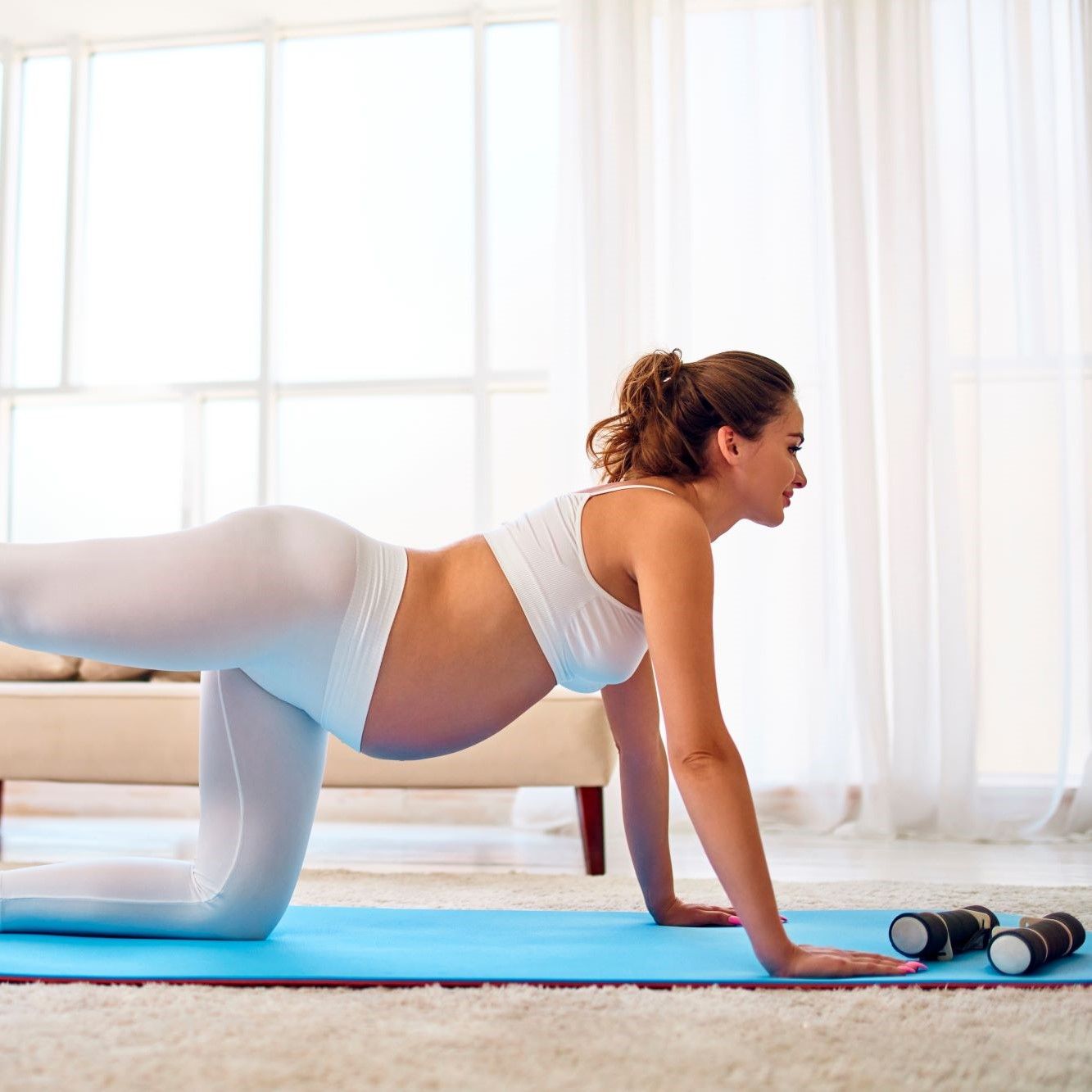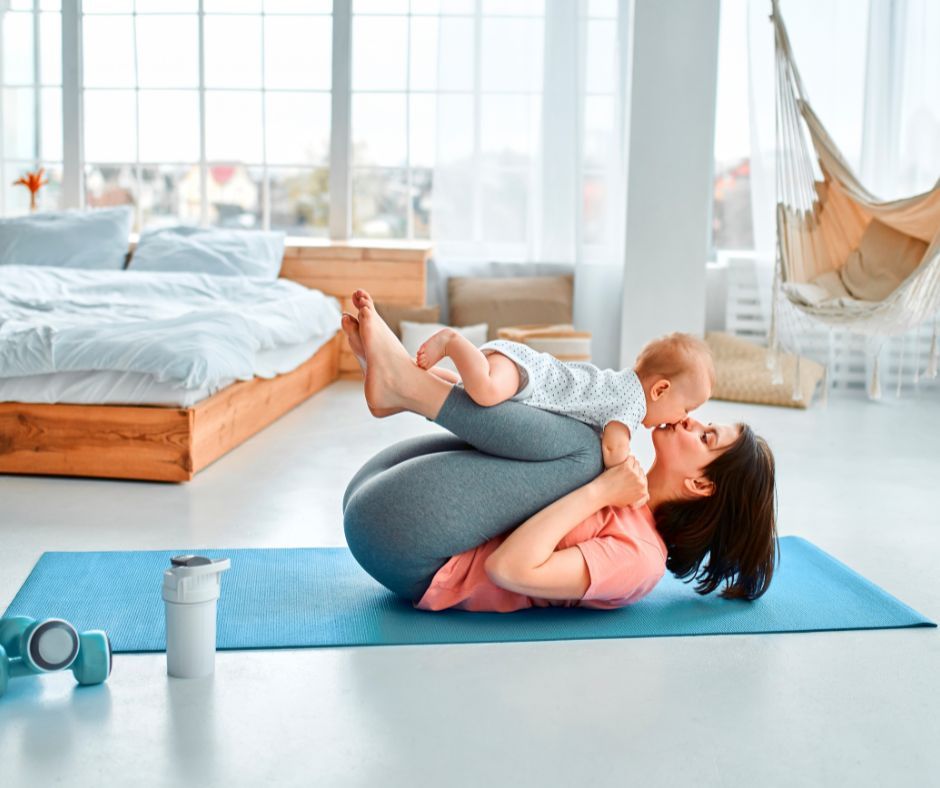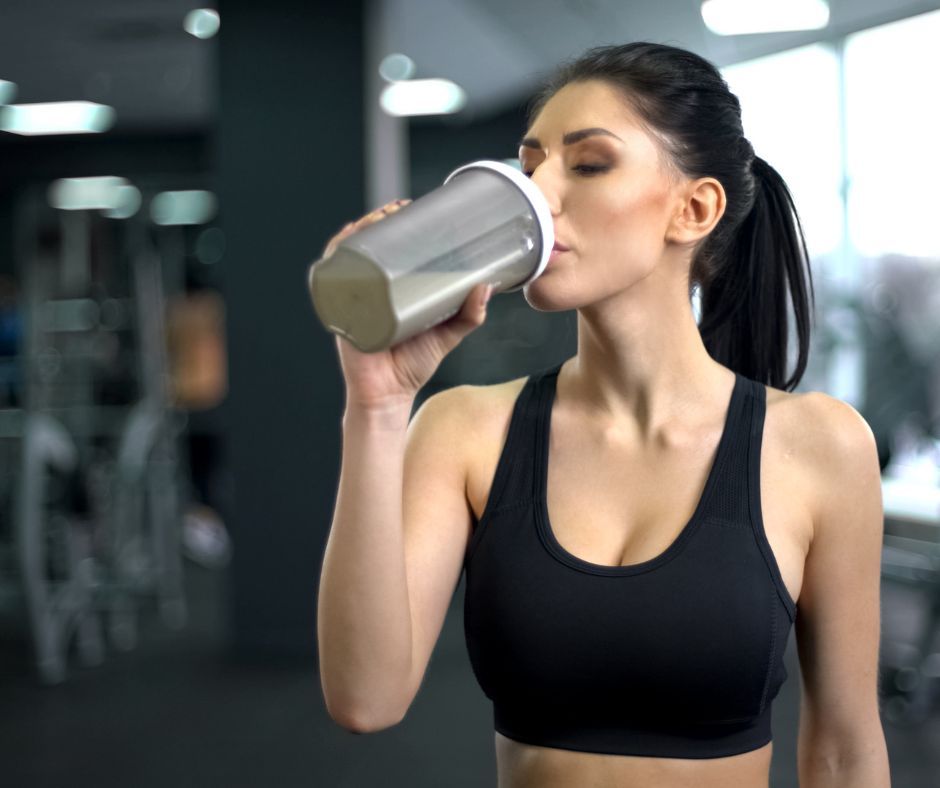Growing (toning) muscle requires the use of enough load to help provide enough intensity to trigger an anabolic response… but what do you do if you’re limited in how much weight you have to lift? The good news is that with certain strategies, you can work around this issue by incorporating some advanced training strategies such as creating a greater mechanical disadvantage, isolation exercises, utilising active insufficiency, increasing metabolic stress, and increasing load in any way possible to help keep light weights as challenging as possible. Doing so can help to keep the gains-train rolling and at least help to mitigate wasting of muscle mass.
1. Create a Greater Mechanical Disadvantage
Bones are levers, joints are fulcrums, weights are loads and muscles produce force/effort. Most of the body's muscles are naturally at a mechanical disadvantage but by selecting specific exercise types and making changes to our exercise technique, we can make a group of muscles have a greater mechanical advantage or disadvantage. With light weights, we want to try and make them as disadvantaged as possible. There are 2 ways we can do this:
- Using specific exercises
- Altering exercise technique
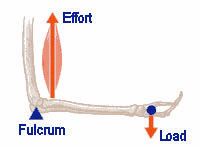
1.1 Exercise Selection
Instead of changing exercise technique, we can just select exercises that automatically create a greater mechanical disadvantage. Any exercise that places the weight further away from the joint that is rotating to move it will cause the muscles to work a lot harder to generate the force needed to overcome the load. For example, deadlifts and their variations, good mornings, hip thrusts and glute bridges are all exercises that require the hips to flex and extend to move the load, however, they all place the load at different distances from the hip, with good mornings being the furthest. Glute bridges and hip thrusts are going to require the least amount of force generated by the hip muscles to move the load; deadlifts and their variations will require more force to be generated than deadlifts, and good mornings will require the greatest amount of force to be generated to move the load. When selecting an exercise, using one that places the load furthest away from the joint will result in the least amount of weight required to stimulate the muscles involved.
1.2 Altering Exercise Technique
If you can’t change where the load is placed on the body by all too much, such as with split squats and lunges, then you can alter your posture, range of motion and coordination of movement instead to help increase the tension on a particular muscle group. For example, if you’re doing a split squat and want to target your quads more, you could perform it with a narrower stance to create a greater mechanical disadvantage for the quads and increase the intensity. This slight tweak in your stance will force your torso into a more upright position and consequently shift your centre of mass closer to your hips, and force your knees to travel further forward, consequently creating a longer moment arm (the distance between the fulcrum and another point) for the load (i.e., your body weight and any weight loaded on you) and a greater mechanical disadvantage for the quads. Some other examples include:
- Biceps curls with your elbows slightly forward of your torso
- Pec flies with your elbows flexed as little as possible
- Wide push-ups
- Stiff-Leg deadlifts
By moving the load further away from the joint, either with a specific exercise or technique, you can significantly increase the intensity of the exercise.
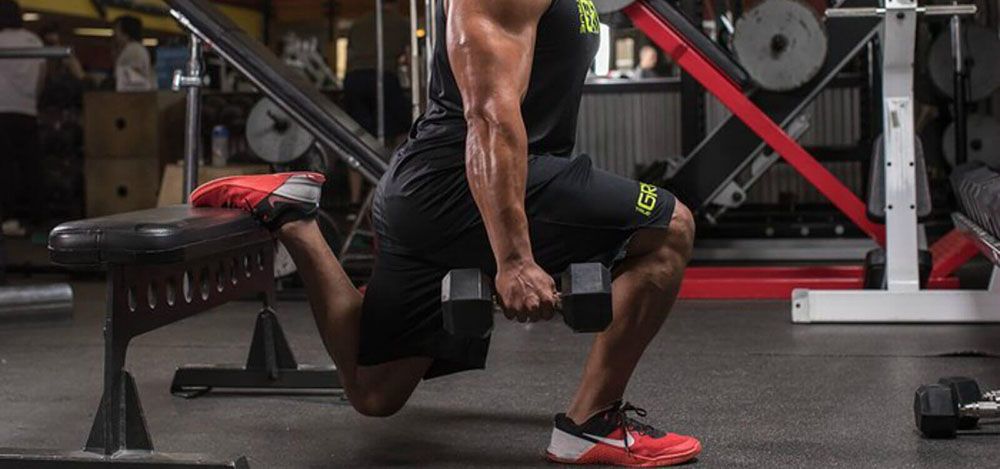
2. Isolation Exercises
Ever been told compound exercises are the way of the future and isolation exercises have no place in any program? Well, turns out they didn’t see COVID-19 coming. Isolation exercises can help to preferentially recruit fewer muscle groups to move a load and make light weights incredibly more taxing compared to compound exercises. For example, dumbbell pec flies create a lot more tension on the pec major than dumbbell presses for the same weight. This is for two reasons:
- The longer lever arm created by a straight arm with the pec fly provides a greater mechanical disadvantage for the pecs, making the exercise a lot more intense for the same weight.
- The triceps cannot assist in the movement. It’s as simple as that – the fewer number of muscles that can assist a movement, the greater the amount of force a single muscle group must generate to move the load, and therefore the less weight required. This brings us to our next strategy.
3. Active Insufficiency
Similar to isolation exercises, you can also use the power of active insufficiency to help limit the involvement of a specific muscle group as much as possible and force another muscle group(s) to work harder. Most muscles of the body only cross one joint (e.g., the pecs and lats), but some cross more than one joint, such as the rectus femoris (part of the quads), hamstrings, the biceps brachii, long head of the triceps and gastrocnemius. When these muscles shorten at one end, they can’t generate as much force as when it’s lengthened at both ends, thus forcing other muscles involved in flexing/extending a particular joint to work harder (1).
3.1 The hamstrings
All but one muscle of the hamstrings cross both the knee and hip joint and are therefore the primary movers for knee flexion and assist with extension of the hip. If you were to flex the knee, say like in a glute bridge position, you can limit how much force the hamstrings generate to assist with extending the hips, thus making the glutes work a lot harder. The more you flex the knee, the more the glutes have to work. Therefore, with the same weight (bodyweight or weight added) a glute bridge with the feet close to the buttocks forces the glutes to work harder than when the feet are further away. By completing leg curls with your hips extended (e.g., lying flat on your stomach with no bend at the hips), the muscles of the hamstrings (semimembranosus, semitendinosus and long head of the biceps femoris) cannot generate as much force as usual and, therefore, the short head of the biceps femoris (which only crosses the knee joint) has to work a lot harder and generate more force than it would otherwise to help overcome the load.
3.2 The Quads
The quads consist of 4 muscles; the vastus lateralis, the vastus medialis, the vastus intermedius and the rectus femoris. All except for the rectus femoris cross only one joint only – the knee joint. The rectus femoris crosses both the knee and hip joint. By completing a seated leg extension with an upright torso, the rectus femoris undergoes active insufficiency and cannot generate as much force to help extend the knee. Consequently, the 3 other quad muscles must work harder.
3.3 The Triceps
The triceps are made up of three muscles; the long head, lateral head and medial head. The lateral and medial head cross the elbow joint only, while the long head crosses both the elbow and shoulder joint. By bringing your arm closer to the side of your body, you shorten the long head of the triceps at the shoulder joint and force the lateral and medial head of the triceps to work a lot harder. Some exercises that allow you to take advantage of this include:
- Lying overhead extensions
- Push-downs
- Kickbacks
3.4 The Biceps
The elbow flexors consist of the biceps brachii, brachialis and brachioradialis. The biceps brachii consists of two muscles; the long head and the short head. Both cross the elbow and shoulder joint. The brachialis and brachioradialis cross the elbow joint only. Therefore, when the shoulder is flexed (the upper arms are brought up toward the head), the long and short head of the biceps brachii experience active insufficiency and therefore force the brachialis and brachioradialis to work harder. Also, the short head of the biceps brachii doesn’t experience as much shortening as the long head when the shoulder is both flexed and abducted (brought out to the side life as if to show off your biceps). Therefore, the short head has to work harder when the shoulder is flexed and abducted compared to when the arm is closer by the side (like in a standing biceps curl).
3.5 The Calves
The calf muscles consist of the soleus and the gastrocnemius. The soleus only crosses the ankle joint while the gastrocnemius crosses both the ankle and knee joint. By completing calf raises in a seated position with the knees flexed, the gastrocnemius is shortened at the knee end and experiences active insufficiency, thus making the soleus work harder.
Shortening a muscle that crosses over two joints at one end will reduce its ability to produce force and, consequently, force other assisting muscles to work harder.
4. Increase Metabolic Stress
While load (i.e., mechanical tension) plays a significant role in building muscle mass, it’s not the only factor. Metabolic stress is another factor that plays a significant role in driving muscle hypertrophy (2) and you don’t need very heavy weights to create a lot of metabolic stress. The main mechanism that metabolic stress can help to drive muscle hypertrophy is likely the recruitment of high-threshold motor units (HTMU’s).
When a muscle completes work, it does so using the size principle. Smaller, weaker, and more fatigue resistance fibers that are controlled by low-threshold motor units are recruited first. As they start to fatigue and/or cannot produce enough force to maintain the work, larger, stronger and less fatigue-resistant muscle fibers that are controlled by HTMU’s are recruited (3).
There are 5 main ways we can increase metabolic stress within a muscle:
- High-rep sets
- Reduced rest times
- Pre-Exhaust muscles
- Compound sets
- Blood flow restriction training
4.1 High-Rep Sets
With every rep that you perform, metabolic waste products are produced and start to accumulate within the muscle cells as they cannot be removed at a fast enough rate. The increasing levels of these waste products within the muscle cause fatigue and thus results in HTMU’s being increasingly recruited to help continue producing work.
While you may be limited in the amount of weight available to you to create mechanical tension, completing a lot of reps (15-20+) close to failure can be just as effective as lifting heavier weights for muscle hypertrophy. In fact, studies have shown that different ranges of reps from low (1-6 reps) to moderate (6-12) to high rep ranges (15+) can all result in roughly equal muscle hypertrophy (4). Therefore, if you typically tend to stick to high load, low rep ranges, this could be a great opportunity to give your tendons a break and train in the higher rep ranges without risking a loss of gains.
4.2 Reduced Rest Times
When a set is complete, the body has the opportunity to remove the waste products produced. However, if the rest time is kept short (30-60 seconds), not all waste products will be removed. Therefore, when the next set starts, there will already be an accumulation of waste products and fatigue, consequently forcing HTMU’s to be recruited sooner in the set and having the same effect as higher rep sets, despite not necessarily being able to complete as many reps.
4.3 Pre-Exhaust Muscles
While I don’t ever really use this strategy for myself or with clients in a normal setting as there’s likely to be very little benefit to it and could actually negatively impact muscle building potential compared to more traditional styles of training, this is one situation where there may actually be good logic to it.
The idea behind the pre-exhaustion strategy is that a specific muscle group is exhausted with an isolation exercise set before a compound exercise set, thus making the targeted muscle reach failure sooner than it usually would within the compound exercise set. In a normal gym setting, you have all the weight you could possibly ever need to fatigue a muscle close enough to failure within a certain number of reps, but when you’re training with very limited weights, it’s a whole different ball game! By pre-exhausting a muscle with an isolated exercise that doesn’t require a ridiculous number of reps to get (close) to failure, you can significantly impair that muscle’s strength capacity in the following compound set so that you can complete a more modest number of reps with the limited weight you have.
For example, if you’re doing a dumbbell chest press and only have two 10 kg dumbbells, you might be able to complete 40+ reps with them – hardly useful. However, completing a pec fly with 10 kg is actually pretty challenging and most will only be able to achieve between 10-20 reps. By going to failure with pec flies and then immediately moving to dumbbell presses, you’ll be able to reduce the number of reps you can complete from 40+ to maybe 20 instead – a much more practical number of reps for hypertrophy purposes.
There are many exercise combinations you can perform this strategy with, such as:
- Lying band leg curls before stiff-leg deadlifts
- Single-leg resistance band leg extensions before split squats or lunges
- Front raises before overhead press
- Lateral raises before upright rows
- Glute bridges before Romanian deadlifts
- Triceps extensions before close push-ups
4.4 Compound Sets
Many would be familiar with supersets and many probably already do compound sets without realising it. A compound set is when two exercises that train the same muscle group are paired together. The first exercise is completed and the second exercise begins almost immediately after. A full rest period is taken before repeating the process. By training the same muscle group with two different exercises, metabolic stress is increased as the muscle doesn’t have the opportunity to remove the metabolites – similar to effects of high rep sets and short rest periods – and consequently forces the HTMU’s to be recruited to continue work. Some examples of compound sets include:
- Push-ups with pec flies
- Overhead press with front raises
- Upright rows with lateral raises
- Pull-ups with bent-over rows
- Goblet squats with reverse lunges
- Romanian deadlifts with glute bridges
4.5 Blood Flow Restriction Training
Blood flow restriction (BFR) training, also known as KAATSU or occlusion training, involves applying just enough pressure to the proximal (closest to the core of the body) ends of the limbs to limit blood flow into and out of the muscles without completely inhibiting blood flow supply. By limiting blood flow into and out of the muscle, metabolites cannot be removed as quickly and, consequently, early onset of fatigue can be induced which, just like high rep and short rest periods, forces HTMU’s to be recruited to continue producing sufficient force and work at significantly less load than traditional training.
BFR training actually has a lot of research supporting its use for muscle strength and hypertrophy and has been shown to be extremely effective with loads as low as 20% 1-RM (5)! Something that is practically impossible with traditional training and makes it perfectly suited for light weight training. Think about that for a second. If your squat 1-RM is 100 kg and you typically complete sets of 70 kg (70% 1-RM) for around 10-12 reps to grow muscle, you could now use as little as 20 kg and still make gains in your quads!
Better yet, studies utilising BFR training have shown it results in as much muscle hypertrophy in just 2 weeks as compared to 3-4 months of traditional training (6)! The reason for this is that exercise-induced muscle damage (EIMD) is near non-existent in BFR training due to the low loads used, unlike traditional training methods that result in significant EIMD due to the higher loads used and, therefore, can be completed with a significantly higher frequency – as high as twice per day. With BFR training, it’s possible to complete up to 24 workouts in just two weeks!
The one major downfall with BFR is that you can only limit the blood flow to the muscles of the limbs (arms and legs) and cannot limit blood flow to the muscles of the trunk (shoulders, chest, back, glutes and core). However, if you only have light weights available, the muscles of the legs (quads, hamstrings and calves) are amongst the those that you’re probably going to be most limited with and need the help of BFR training the most to continue making or retaining gains.
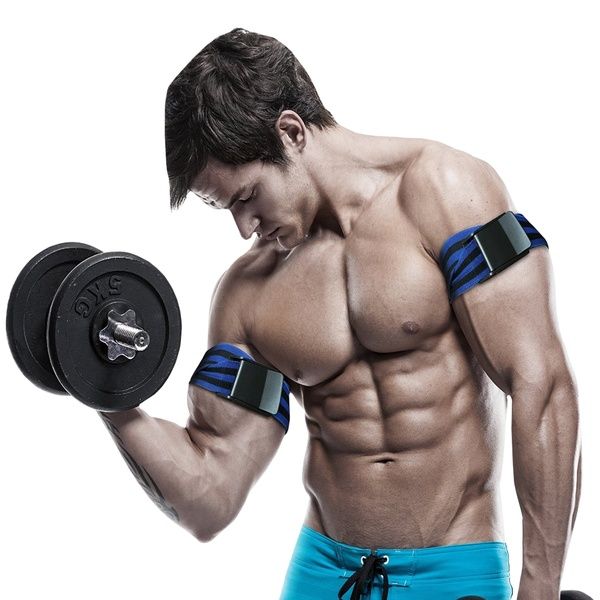
How to Set Up BFR Training
- Place a band around the proximal end of the limb(s) that is tight enough to reduce blood flow but not completely inhibit it. 1.1 The ideal amount of pressure is between 100-240 mmHg. Larger muscles, such as the thighs, do not require as much pressure as smaller muscles, such as the biceps and triceps. How much body fat there is on the limb will also affect how much pressure is required, with more body fat requiring greater pressure. Now, you probably don’t have a pressure cuff to measure the pressure of the band so precisely, in which case, I recommend using just enough pressure that swelling of the limbs occurs and light weights feel heavy. If the limb starts to go numb or pale in colour, then you’ve used too much pressure. 1.2 The type of band you use is also very important; don’t use something very narrow, such as fine string or fishing wire (otherwise your limb will fall off!) – use something thicker such as rubbing tubing, a cord, or a thick elastic band. Also, ensure it’s something you can take off quickly and safely.
- Keep the band on for the duration of the working sets of an exercise but no longer than about 15 minutes at a time.
- Use loads of 20-50% 1-RM for high reps and close to failure
- Use short rest times of 30-60 seconds between sets
Medical Conditions
Although very safe, BFR training may increase blood pressure beyond that normally experienced with high-intensity training. Therefore, those with cardiovascular conditions should use less pressure, a lower duration, and a lower level of exertion.
Creating a high degree of metabolic stress with strategies such as high reps, short rest periods, pre-exhaustion, compound sets and BFR training can help to drive muscle hypertrophy with light weights.
5. Increase Load
You may be stuck with light dumbbells and kettlebells, but there are still ways to increase the load – you just have to think outside of the box and get a bit creative! There are 5 main ways you can add or create more load to the limited weights you have:
5.1 Unilateral Training
Many of your bilateral exercises will become just too light to do with bodyweight – this becomes especially the case for lower body exercises. However, two arms or two legs can lift a lot more weight than one arm or leg… so why not do these exercises with just one limb? For example, you may be able to complete 40-50 reps of a goblet squat, which would be excessive, but do you think you could complete as many reps of a Bulgarian split squat? Hell no! Shifting all of your weight on to one leg can increase the intensity of the exercise significantly.
5.2 Resistance Bands
One of the easiest ways to increase the load with just about any exercise is to get your hands on one or two resistance bands. By looping them around a table leg or parts of your own body, you can significantly increase the load. As a band stretches, its tension increases exponentially, meaning that when it’s stretched 10 cm, it doesn’t take twice as much force to stretch as 5 cm – it takes a lot more! With a resistance band looped around your shoulders and feet, you could create loads in excess of 100 kg during a squat!
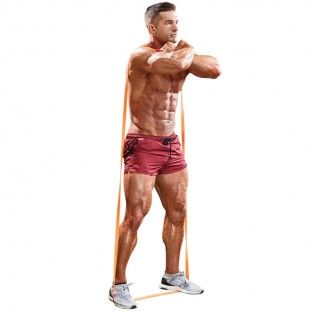
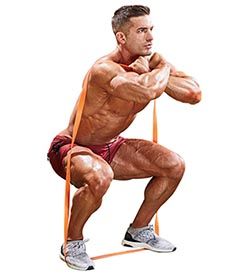
5.4 Large Water Containers
Pretty straight-forward. One trick you can do to help make the load easily adjustable is to get the biggest container you can find (ideally 5+ L) and weigh out the container with 1 kg worth of fluid and make a mark on the water container, then 2 kg of fluid, 3 kg etc. That way, you can easily pour out and top up the water container to vary its weight. By the way, 1 L of water = 1 kg, so if your container has volume markings on it, that’s a simple way to measure out its weight.
5.5 Filling a Backpack With Heavy Objects
Fill it with anything and everything! Water bottles, bricks, rocks, sand, dirt, etc.
5.5 Holding/Carrying Heavy Objects
A couch, your pet, kids, partner, grandmother – whatever! Just make sure the risk of dropping them is low and they don’t exceed your strength capabilities.
There are often many ways you can increase the load of an exercise aside from the lifting equipment you have available to you - resistance bands being one of the best.
Conclusion
Although only having access to light weights is not ideal for muscle hypertrophy, it’s still very possible to get a lot of solid work in to stimulate muscle growth – you just have to be a lot more strategic with how you train and what you utilise. By creating a greater mechanical disadvantage, isolation exercises, utilising active insufficiency, increasing metabolic stress, and adding load wherever possible, you can still reap many of the benefits of having access to heavier equipment. You can use just one method or use a combination of methods at any one time to help alter the stimulus over time and continuously progress the difficulty of the exercises.
References
- Schoenfeld, B. (2002). Accentuating muscular development through active insufficiency and passive tension. Strength & Conditioning Journal, 24(4), 20-22.
- Schoenfeld, B. (2013). Potential Mechanisms for a Role of Metabolic Stress in Hypertrophic Adaptations to Resistance Training. Sports Med, 24(10), 179–194 . https://doi.org/10.1007/s40279-013-0017-1
- Haff, G., & Triplett, N. T. (2016). Essentials of strength training and conditioning. Champaign, IL: Human Kinetics.
- Schoenfeld, B. J., Grgic, J., Ogborn, D., & Krieger, J. W. (2017). Strength and Hypertrophy Adaptations Between Low- vs. High-Load Resistance Training. Journal of Strength and Conditioning Research, 31(12), 3508–3523. doi: 10.1519/jsc.0000000000002200
- Loenneke, J.P., Wilson, J.M., Marín, P.J. et al. Low intensity blood flow restriction training: a meta-analysis. Eur J Appl Physiol 112, 1849–1859 (2012). https://doi.org/10.1007/s00421-011-2167-x
- Yasuda, T., Abe, T., Sato, Y., Midorikawa, T., Kearns, C. F., Inoue, K., Ishii, N. (2005). Muscle fiber cross-sectional area is increased after two weeks of twice daily KAATSU-resistance training. International Journal of KAATSU Training Research, 1(2), 65–70. doi: 10.3806/ijktr.1.65



